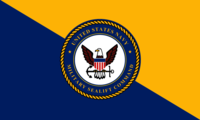
Back Military Sealift Command Czech Military Sealift Command German Military Sealift Command Spanish Military Sealift Command French Military Sealift Command Italian 軍事海上輸送司令部 Japanese 군사해상운송사령부 Korean Karinių jūrų pervežimų junginys Lithuanian Military Sealift Command NB Командование морских перевозок Russian
| Military Sealift Command | |
|---|---|
 The official seal of Military Sealift Command. | |
| Active | 9 July 1949 – present |
| Country | |
| Branch | |
| Type | Component Command |
| Role | Sea-based transportation |
| Headquarters | Naval Station Norfolk, Norfolk, Virginia, U.S. |
| Commanders | |
| Current commander | |
| Insignia | |
| Flag |  |
The Military Sealift Command (MSC) is an organization that controls the replenishment and military transport ships of the United States Navy. Military Sealift Command has the responsibility for providing sealift and ocean transportation for all US military services as well as for other government agencies. It first came into existence on 9 July 1949 when the Military Sea Transportation Service (MSTS) became solely responsible for the Department of Defense's ocean transport needs. The MSTS was renamed the Military Sealift Command in 1970.
Military Sealift Command ships are made up of a core fleet of ships owned by the United States Navy and others under long-term-charter augmented by short-term or voyage-chartered ships.[3]
- During a time charter MSC takes control of a merchant ship and operates it for the chartered amount of time. During this time the ship is crewed by civilian mariners and MSC pays for all expenses. Time chartered ships are not subject to inspections from foreign governments when in port, and MSC has operational control.
- Voyage chartered ships are crewed by civilian mariners, and MSC only pays the fee for transporting the cargo. These ships are chartered for the voyage, subject to inspections, and MSC does not have operational control of the ship.[4]
The Navy-owned ships carry blue and gold stack colors, are in service with the prefix USNS (United States Naval Ship), rather than in commission (with a USS prefix), have hull numbers as an equivalent commissioned ship would have with the prefix T- and are primarily civilian crewed by either civil service mariners[5] or contract crews (see United States Merchant Marine) as is the case of the special mission ships.[6] Some ships may have Navy or Marine Corps personnel on board to carry out communication and special mission functions, or for force protection.[7] Ships on charter or equivalent, retain commercial colors and bear the standard merchant prefix MV, SS, or GTS, without hull numbers.
Eight programs compose Military Sealift Command: Fleet Oiler (PM1), Special Mission (PM2), Strategic Sealift (PM3), Tow, Salvage, Tender, and Hospital Ship (PM4), Sealift (PM5), Combat Logistics Force (PM6), Expeditionary Mobile Base, Amphibious Command Ship, and Cable Layer (PM7) and Expeditionary Fast Transport (PM8).
MSC reports to the Department of Defense's Transportation Command for defense transportation matters, to the Navy Fleet Forces Command for Navy-unique matters, and to the Assistant Secretary of the Navy (Research, Development and Acquisition) for procurement policy and oversight matters.[8]
- ^ "BIOGRAPHIES". www.msc.usff.navy.mil. Retrieved 19 September 2023.
- ^ "SOBECK TAKES COMMAND OF MILITARY SEALIFT COMMAND AS WETTLAUFER RETIRES". Retrieved 19 September 2023.
- ^ "Sealift Ships". Military Sealift Command. Archived from the original on 29 August 2007. Retrieved 19 April 2013.
- ^ "Navy contracting: Ship chartering practices of Military Sealift Command" (PDF). 25 October 1989. Retrieved 26 April 2022.
- ^ "Combat Logistics Force". Military Sealift Command. Archived from the original on 17 February 2013. Retrieved 19 April 2013.
- ^ "Special Mission Ships". Military Sealift Command. Archived from the original on 25 April 2013. Retrieved 19 April 2013.
- ^ "Military Sealift Command: People". Military Sealift Command. 2014. Archived from the original on 25 November 2014. Retrieved 6 November 2014.
- ^ "About MSC". U.S. Military Sealift Command. Archived from the original on 17 September 2014. Retrieved 21 August 2014.
© MMXXIII Rich X Search. We shall prevail. All rights reserved. Rich X Search